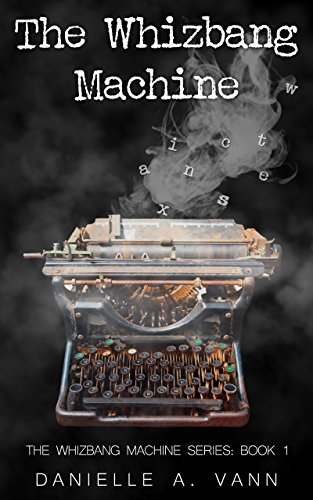
![]() The Whizbang Machine by Danielle A. Vann
The Whizbang Machine by Danielle A. Vann
Fifteen year old Elizabeth Yale has been living alone with her mother for eight years, since her father suffered an untimely death and her beloved grandfather Jack, unable to cope with the tragedy, left town to travel around the world. Elizabeth has missed Jack terribly, so she’s delighted when she gets a letter from Jack announcing that he’s coming home, and even more excited when her mother agrees to let her take a trip to Morocco with Jack in a few days. But unexpected troubles postpone their Casablanca adventure.
Jack has brought an unusual gift home for Elizabeth, an antique typewriter. Elizabeth has an uneasy feeling about the typewriter, especially when Jack insists that she touch the keys. At first nothing happens, but then the typewriter bursts into life with a Pop-Whiz-BANG!, shooting streams of brightly colored sparks and lit-up letters into the air and causing the room to shake violently. When Elizabeth types a message on the keys, the typewriter types a response: “It’s a lie. All of it, a lie.” The machine soon informs Elizabeth that history is not right and she needs to correct it. Its cryptic messages gradually lead Elizabeth and her grandfather down a path to explore their family’s past ― including a family curse that has killed before, and is waiting to kill again. It’s a race to solve the mystery before anyone else dies!
Danielle A. Vann has created an original middle grade mystery in The Whizbang Machine (2016), with a unique concept, the ancient, magical typewriter, at the center of it, and an engaging mystery. Unfortunately the execution of the idea is lacking in many ways. Elizabeth is frustratingly juvenile for her age. She whines constantly, talks back to adults, and makes some impulsive, questionable decisions. Her dialogue and character would be a better fit for a twelve or thirteen year old girl than one who’s turning sixteen in a few weeks.
Her grandfather Jack is just as bad: he takes several actions that clearly don’t have Elizabeth’s best interests at heart, apparently out of impatience or selfish curiosity, like urging Elizabeth to touch the machine again after it’s burnt her fingers badly, sneaking with her into locked buildings, or taking her into danger. His character shifts, from a concerned and loving grandparent to a reckless adventurer and back again, are disconcerting.
Additionally, The Whizbang Machine needed much stronger editing and proofreading. There are repeated punctuation errors, particularly in the dialogue. This book has a desperate case of “saidism” (aka “said bookism”), where the author seems to be allergic to the simple word “said.” Everything that comes out of a character’s mouth is laughed, chomped, uttered, whined, smiled, etc. It got highly distracting after a while, especially when there was a particularly odd choice of verb, such as: “ ‘Yes,’ Jack rushed” or “ ‘The choir must be practicing,’ the man delighted.” Sometimes the word used is also inappropriate for the context, like when “ ‘Unbelievable,’ I laughed” appears in the midst of a serious discussion.
This passage is illustrative of most of the problems I’ve mentioned:
Throttling his hand forward, he opened it and closed it repeatedly, “Hand me the blue map pencil now, young lady,” he demanded.
“Why should I?” I hissed.
“Now!” he demanded.
Jack stewed in his building annoyance, “Sir,” Grandpa Jack began. “That is no way to speak to a young lady.”
Younger teenage readers may not mind these literary shortcomings. On the positive side, the plot is generally fast-paced. There’s some exciting action as Jack and Elizabeth travel to far-off places in search of the answers to the mystery and the key to unlocking the curse. However, be aware that The Whizbang Machine ends on a major cliffhanger, with the mystery unresolved. Readers will have to wait for the publication of the sequel, Tunney’s Curse, to get more answers.



I love the idea of a magical typewriter. It does seem like stronger editorial support would have helped.
Have I mentioned that I have a copy of THE SAID BOOK? It is a prized possession, and lots of fun at parties (particularly parties with lots of readers/writers).
The Said Book sounds like so much fun! I’d love to see it. From my brief foray into Said Bookism while writing this review, it appears that at one point authors were strongly encouraged to use mostly words other than “said,” but the pendulum has swung back as writers and publishers became aware that overdoing this is too distracting for the reader. “Said” may be boring, but it’s effectively an invisible word that the reader’s eyes and mind just skip over.
I think it was a minority of self-styled writing “experts” who encouraged the said-book practice. I don’t usually link to my blog, but here is my post about the J.I. Rondale book, which is worth its weight in the steaming blood of innocent verbs.
http://deedsandwords.com/?p=3381
I’m delighted beyond words to find out that The Said Book is an actual book, and that it takes itself entirely seriously. And now, after reading your blog entry and the comments, I’ve gained a new aversion to the word “very.”